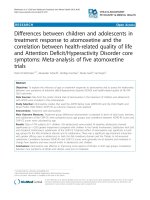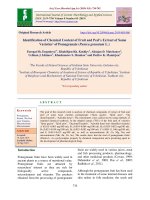Correlation between different morphological traits of pomegranate (Punica grantum)
Bạn đang xem bản rút gọn của tài liệu. Xem và tải ngay bản đầy đủ của tài liệu tại đây (229.82 KB, 5 trang )
Int.J.Curr.Microbiol.App.Sci (2019) 8(1): 981-985
International Journal of Current Microbiology and Applied Sciences
ISSN: 2319-7706 Volume 8 Number 01 (2019)
Journal homepage:
Original Research Article
/>
Correlation between Different Morphological Traits of
Pomegranate (Punica grantum)
Shaili Kumari*, M.R. Dinesh, B.N.S. Murthy, K.M. Shankaran,
D.C. Lakshmana Reddy, K.S. Shivashankara, Kanupriya and K.K. Upreti
Division of Fruit Crops, ICAR-IIHR, Hesaraghatta, Bengaluru, 560089, Karnataka, India
*Corresponding author:
ABSTRACT
Keywords
Morphological
characterization,
Correlation, Growth
parameters,
Analysis of
Variance, Fruit
characteristics
Article Info
Accepted:
10 December 2018
Available Online:
10 January 2019
Pomegranate is quite popular among consumer for its striking, sweet acidic taste and
refreshing arils. Pomegranate is one of the ancient fruit crops which were originated in
Iran. Total 151 pomegranate genotypes along with their hybrid parents (Bhagwa, DF,
Nana) combinely 154 used for morphological characterization. Total 13 morphological
parameters were used for characterization and Analysis of Variance, mean comparison and
simple correlations were analysed. Significance differences (P<0.05) were found among
all the genotypes of pomegranate. Highest critical differences at 5% were 13.21 (Fruit
weight), 11.98 (Aril %), 2.552Thorn {No/Shoot length (m)} recorded and lowest in leaf
blade width 0.143, 0.145 in leaf blade length, 0.456 in fruit length and 0.48 in seed
hardiness respectively. Plant growth parameters, leaf parameters and fruit parameters are
significantly correlated to each other. Fruit weight and seed hardiness was negatively
correlated to each other (r= -0.42). Those fruit have larger size and weight have less seed
hardiness. Fruit characteristics are negatively correlated with leaf characteristics (r= 0.22).The largest the leaf size smallest the fruit size.
Introduction
Pomegranate is quite popular among
consumer for its striking, sweet acidic taste
and refreshing arils. Pomegranate is one of the
ancient fruit crops which were originated in
Iran. Now a day its demand is growing for the
processing purpose (Pruthi and saxena, 1984).
It can produce fruit in Tropical, subtropical
and temperate conditions. Pomegranate can
produce fruit up to 1800 msl (Sharma and
Sharma 1990).Pomegranate is classified under
often cross pollinated crop but still have
narrow genetic base, only two species existing
under Punicaceae family Punica granatum
and Punica protopunica. So far a very less
number of varieties were developed through
systematic hybridization. Earlier reported
chromosome number of cultivated species
Punica granatum was 2n=2x=16, 18 (Singh,
2004). Shieldi et al., (2005) observed
chromosome number in his study was
2n=2x=16.Universely pomegranate has gained
commercial importance for their physico
chemical characteristics. Pomegranate fruit
colour varies from yellow (Ganesh) to red
981
Int.J.Curr.Microbiol.App.Sci (2019) 8(1): 981-985
(Bhagwa) and average fruit weight was about
250-300g (Patil et al., 2013). Aril colour
varies from white to dark red. Ovate, oval and
round fruit shape was observed in
pomegranate. Aril taste varies from sweet
(Bhagwa) to sour insipid (Daru, Nana)
(Saxena et al., 1987).TSS recorded in Ganesh,
Arakta and kesar was 14.5 0 B, 13 0 B, 140 B
with 0.57, 0.59, and 0.59 per cent acidity,
10.4, 10.2 and 9.65 % total sugars,8.40,8.00
and 7.3 % reducing sugars, 2.00,2.20 and 2.35
% non-reducing sugars (Patil et al., 2005).
Jagtap et al., (1992) analysed 29 pomegranate
cultivars for their growth and fruit characters
and classify the genotypes into the following
growth habit (spreading, erect, semispreading), foliage nature (Deciduous, semideciduous, evergreen). He observed that
growth habit of tree based on height to spread
ratio. Thakur et al., (2010) used twenty
pomegranate cultivars from Iran for their
biochemical traits and antioxidant activity.
The experiment reported that significant
differences among the cultivars. Ercisli et al.,
(2011) evaluated pomegranate fruit physical
characteristics to recognise that which
parameters are related to size. Fruit
parameters, like fruit volume and weight, aril
weight and number, pericarp weight, seed
weight, and juice/pulp content, were assessed
in a sample of fruits of variable sizes of
‘Wonderful’ pomegranate. Results showed
that fruit volume, fruit weight, and total aril
weight were correlating each other. Any one
of these characteristics can be considered as
an indicator of fruit size. Among them arils
numbers per fruit was highly correlated with
fruit size.
Materials and Methods
Total 151 pomegranate genotypes along with
their hybrid parents (Bhagwa, DF, Nana)
combinely 154 conserved at Division of Fruit
crops, IIHR, Bengaluru, were be used for
morphological characterization. The details of
this genotype are given in Table 1 is used for
characterization. Total 13 morphological
parameters were used for characterization;
these are as follows plant height, plant spread,
growth habit, thorn no/shoot length, Fruit
weight (g), Fruit length (cm), Fruit width
(cm), Fruit peel thickness(mm),Aril(%), Seed
hardiness (N/mm), Leaf blade length (cm),
Leaf blade width (cm), Petiole length (mm).
Analysis of Variance, mean comparison and
simple correlations were analysed in SPSS and
SAS software (Mehr et al., 2012).
Results and Discussion
Significance differences (P<0.05) were found
among all the genotypes of pomegranate
(Table 2). There was the quite variation in the
mean and range of different plant
characteristics which enlisted in Table 3.
Highest critical differences at 5% were 13.21
(Fruit weight), 11.98 (Aril %), 2.552Thorn
(No/Shoot length (m)) recorded and lowest in
leaf blade width 0.143, 0.145 in leaf blade
length, 0.456 in fruit length and 0.48 in seed
hardiness respectively. The result obtained
was quite similar to result obtained in the
research of (Karimi et al., 2009).
The correlation between each pair of trait was
calculated enlisted in Table 3. Vegetative
growth parameters like plant height and plant
spread was positively correlated with each
other. Correlation between plant height and
plant spread (r= +0.23). Growth habit of plant
was determined based on height and spread
ration (Jagtap et al., 1992). Thorn (No/shoot
length (m)) was one of the important
vegetative characteristics of pomegranate and
it negatively correlated with plant spread and
growth habit (r= -0.085) and (r= -0.20). Leaf
parameter was positively correlated with each
other. Leaf length and leaf breadth are
significantly correlated with each other (r=
+0.81) and leaf width and leaf length was
positively correlated petiole length (r= + 0.75)
and (r=+ 0.88).
982
Int.J.Curr.Microbiol.App.Sci (2019) 8(1): 981-985
Table.1 Pomegranate genotypes used for morphological characterization
Group
of Genotypes name
genotypes
9/8,14/20,18/16,
9/14,
15/2,18/20,9/16,15/4
Hybrid
,9/7,11/10,15/7,11/812/5,15/18,12/6,
12/10,16/3,
(Bhagwa
x
13/6,12/12,16/4,14/8,13/3,16/5,15/5
13/4,16/10,14/2,13/11,16/20,
DF x Nana)
15/1,13/12,17/6,16/1,13/20,17/13,17/2
14/6,17/18,17/3,14/11,9/6,17/7,14/12,18/1,18/3,14/16,18/4,18/5,14/19,18/10
1/1,5/6 ,11/10,1/8,5/13,11/17,1/10,5/19,11/18,1/18,
6/4
,12/1,1/19,
Mutant
7/5,12/22/13,7/8,12/5,2/14,7/12,12/7,
2/19,
7/19,13/13,3/2
(Gamma
,8/8,13/16,3/6 ,8/10,
13/19,3/18,8/11,14/2,
4/6,8/18,14/8,4/11,
Irradiated
9/7,14/14,4/19,9/10,14/19,5/1 10/9,15/7,5/2,10/13,15/9,5/5,10/18
Bhagwa
cutting)
318766,318758,318798,318775,318767,318700,318776,318732,
Wild (Daru
318790318787,318701,318703,318784,318708,318762,318741,318
type)
708A,318735
318741A,318733,318768,318717,318760,318744,318736,318760
,318807318752,318712,318699,318705,318753,318711,318797,318
738,
318749318464,318716,318696,318791,318709,318771,318759,318
951,318750318559,318697,318875,318758,318754,318713
Table.2 Evaluation of pomegranate genotypes for their economic traits
Sl.
No.
1.
2.
3.
4.
5.
6.
7.
8.
9.
10.
11.
12.
Parameter
Plant height (m)
Plant spread(m)
Thorn(No /Shoot
length(m)
Fruit weight(g)
Fruit length(cm)
Fruit width(cm)
Fruit Peel
Thickness(mm)
Aril(%)
Seed
hardiness(N/mm)
Leaf blade
length(cm)
Leaf blade
width(cm)
Petiole length(mm)
Mean
SEm
±
0.041
0.027
0.902
C.D.
at 5%
0.115
0.074
2.552
98.30
5.63
5.24
2.35
20.05(318701) 362.78(14/12) 4.724
3.4(318735)
8.93(318713) 0.163
3.55(318735) 9.033(318713) 0.171
1.15(18/1)
4.305(14/12)
0.068
13.21
0.456
0.477
1.913
235
10.56
57(318699)
4.4(Bhagwa)
778(15/18)
19.6(318750)
4.11
0.172
11.98
0.48
4.48
1.72(Nana)
6.35(318699)
0.052
0.145
1.44
0.65(Nana)
2.43(318699)
4.13
1.52(Nana)
6.46(318699)
0.044
0.059
0.143
0.164
3.3(m)
2.05(m)
16
Range
Minimum
Maximum
0.535(Nana)
4.74(318760)
0.555(Nana)
3.55(318766)
5(12/5)
38(14/11)
983
Int.J.Curr.Microbiol.App.Sci (2019) 8(1): 981-985
Table.3 Bivariate correlations among 13 morphological traits in pomegranate genotypes
1
2
3
4
5
6
7
8
9
10
11
12
13
1
1
0.233445
-0.70729
0.171299
-0.31291
-0.18373
-0.09085
0.147809
-0.42502
0.513035
0.444756
0.450588
0.473264
2
3
4
5
6
7
8
1
0.470473
-0.08588
0.204525
0.275369
0.23381
0.132153
0.173146
-0.15793
0.096609
0.1224
0.096588
1
-0.20009
0.399311
0.268283
0.178476
-0.07131
0.461153
-0.47342
-0.30637
-0.29802
-0.31885
1
-0.24291
-0.26272
-0.15487
-0.21486
-0.205
0.574982
0.307651
0.282228
0.301563
1
0.759172
0.775946
0.117325
0.859517
-0.42168
-0.22729
-0.18895
-0.23515
1
0.921073
0.135965
0.706724
-0.52644
-0.18499
-0.14684
-0.17035
1
0.153535
0.673407
-0.33855
-0.09474
-0.05433
-0.09817
1
0.07565
-0.17907
0.075382
0.073941
0.08405
Plant growth habit (Height/Spread) was
positively correlated with each other (r= +
0.67).Mars (1996) correlated leaf colour with
sour and sweet taste of fruit. The cultivars
with green and smaller leaves are sourer and
sweet cultivars have lighter leaves and larger
leaves. Fruit characters like fruit weight, fruit
length, fruit breadth and aril (%) are
positively correlated to each other. Fruit
weight significantly correlated to fruit length
and breadth (r= +0.75), (r= +0.77).Fruit
weight was positively correlated with fruit
peel thickness (r= +0.11). Fruit weight and
seed hardiness was negatively correlated to
each other (r= -0.42). Those fruit have larger
size and weight have less seed hardiness.
Fruit characteristics are negatively correlated
with leaf characteristics (r= -0.22). The
largest the leaf size smallest the fruit size.
Zamini et al., (2006) studied that fruit
quantitative and qualitative characteristic in
pomegranate. He observed that number of
seed in fruit was negatively correlated to the
9
10
11
12
13
1
-0.46227
1
-0.22739 0.453995
1
-0.25512 0.389859 0.818924
1
-0.19985 0.50321 0.881268 0.753988
1
fruit weight (r=- 72) and positively correlated
with fruit length (r= +74).
References
Ercisli, S., Gadze J., Agar G., Yildirim N. and
Hizarci
Y.,
(2011).
Genetic
relationships among wild pomegranate
(Punica granatum L) genotypes from
Coruh Valley in Turkey. Genetic of
Molecular Research, 10: 459–464.
Jagtap D.B., Desai U.T. and Masalkar S.D.,
(1992). Assessment of pomegranate
germplasm for vegetative and fruit
characters. Annals of Arid Zone, 31(3):
217-219.
Karimi, H.R., Zamani, Z., Ebadi, A., Fatahi.
M.R., (2009). Morphological diversity
of Pistacia species in Iran. Genetic
Resource Crop Evolution, 56: 561-571.
Mars, M. (1996). Pomegranate genetic
resources in the Mediterranean region.
Proceedings plant genetic resources
984
Int.J.Curr.Microbiol.App.Sci (2019) 8(1): 981-985
Meeting, Tenerife, spain 2-4oct: 345354.
Mehr, S.A., Maassoumi, AA., Saidi, A.,
Kazempou O and Ghorbani, N.M.
(2012). Morphological cladistic analysis
of some bifurcate hairy sections of
Astragalus (Fabaceae) in Iran. Turkish
journal of botany, 15: 25-38
Patil A.B., Matapathi S.S., Nirmalnath P.J.
and Patil S.R. (2005). Screening of
pomegranate (Punica granatum L.)
cultivar for wine production. Beverage
and Food World, 32(2): 56-58.
Patil P., Sayed H. M., Joshi A. A. and Jadhav
B. A. (2013). Comparative evaluation of
physico-chemical properties of two
varieties of pomegranate fruits Ganesh
and Arakta. African Journal of Food
Science, 7(11): 428-430.
Pruthi J.S. and Saxena A.K. (1984). Studies
on anardana (dried pomegranate
seeds). Journal of Food Science
Technology, 21:296–299.
Saxena A.K., Manan J.K., and Berry S.K.,
(1987). Pomegranates: post-harvest
technology, chemistry and processing.
Indian Food Packer, 41: 43-60.
Sharma, S.D. and Sharma, V.K. (1990).
Variation for chemical characters in
some promising strains of wild
pomegranate (Punica granatum L.).
Euphytica, 49(2): 131-133.
Shieldi, M., Noormohammadi, Z., Saneghi, A.
and Shahreiyari, Z. H. (2005).RAPD
analysis of eleven Iranian pomegranate
(Punica granatum L.) cultivars. Acta
Biologica Szegediensis, 51(1): 61-64.
Singh, D. B. (2004). Screening of
pomegranate (Punica granatum L.)
cultivars for arid ecosystem. Indian
Journal of Agriculture Science, 74(11):
604-606.
Thakur N.S., Bhat M.M., Rana N and Joshi
V.K., (2010). Standardization of pretreatments for preparation of dried arils
from wild pomegranate. Journal of
Food Science Technology, 47(6):620625.
Zamani, Z., sarkhosh, A., Fatahi, R., Ebadi,
A., (2006). Genetic relationship among
pomegranate genotype studied by fruit
characteristic and RAPD markers.
Journal of horticulture Science and
biotechnology, 82: 11-18.
How to cite this article:
Shaili Kumari, M.R. Dinesh, B.N.S. Murthy, K.M. Shankaran, D.C. Lakshmana Reddy, K.S.
Shivashankara, Kanupriya and Upreti, K.K. 2019. Correlation between Different
Morphological Traits of Pomegranate (Punica grantum). Int.J.Curr.Microbiol.App.Sci. 8(01):
981-985. doi: />
985









